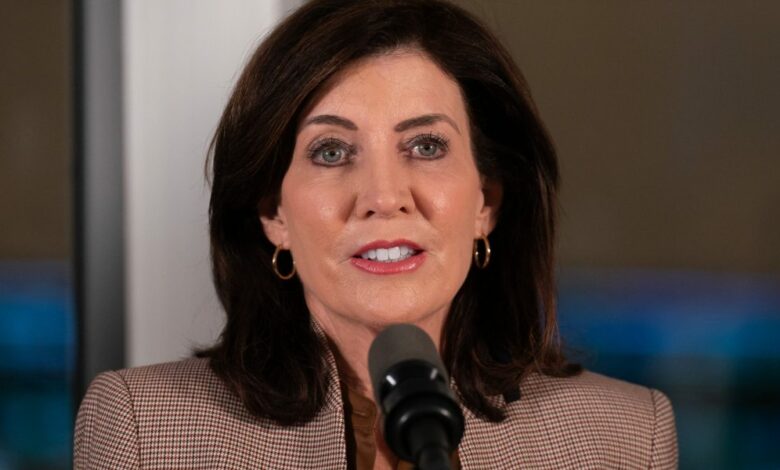Months after $4 billion writedown and calling U.S. ‘most painful part of our portfolio,’ Danish energy giant brings wind farm to New York


America’s first commercial-scale offshore wind farm is officially open, a long-awaited moment that helps pave the way for a succession of large wind farms.
Danish wind energy developer Ørsted and the utility Eversource built a 12-turbine wind farm called South Fork Wind 35 miles (56 kilometers) east of Montauk Point, New York. New York Gov. Kathy Hochul went to Long Island Thursday to announce that the turbines are delivering clean power to the local electric grid, flipping a massive light switch to “turn on the future.” Interior Secretary Deb Haaland was also on hand.
It marks a turnaround from last November, when the Danish company, along with earnings, took a $4 billion writedown as it scrapped its Ocean Wind I and II projects off the coast of southern New Jersey, with some tough talk about the American market. “These are obviously some very tough decisions,” Mads Nipper, Orsted’s CEO, said on an earnings conference call. He said the world’s largest offshore wind developer had decided “to de-risk the most painful part of our portfolio, and that is the U.S.”
Achieving commercial scale is a turning point for the industry, but what’s next? Experts say the nation needs a major buildout of this type of clean electricity to address climate change.
Offshore wind is central to both national and state plans to transition to a carbon-free electricity system. The Biden administration has approved six commercial-scale offshore wind energy projects, and auctioned lease areas for offshore wind for the first time off the Pacific and Gulf of Mexico coasts. New York picked two more projects last month to power more than 1 million homes.
This is just the beginning, Hochul said. She said the completion of South Fork shows that New York will aggressively pursue climate change solutions to save future generations from a world that otherwise could be dangerous. South Fork can generate 132 megawatts of offshore wind energy to power more than 70,000 homes.
“It’s great to be first, we want to make sure we’re not the last. That’s why we’re showing other states how it can be done, why we’re moving forward, on to other projects,” Hochul told The Associated Press in an exclusive interview before the announcement.
“This is the date and the time that people will look back in the history of our nation and say, ‘This is when it changed,’” Hochul added.
South Fork will generate more than four times the power of a five-turbine pilot project developed earlier off the coast of Rhode Island, and unlike that subsidized test project, was developed after Orsted and Eversource were chosen in a competitive bidding process to supply power to Long Island. The Long Island Power Authority first approved this project in 2017. The blades for the 12 Siemens Gamesa turbines reach speeds of more than 200 miles per hour (350 kilometers per hour).
Ørsted CEO Mads Nipper called the opening a major milestone that proves large offshore wind farms can be built, both in the United States and in other countries with little or no offshore wind energy currently.
With South Fork finished, Ørsted and Eversource are turning their attention to the work they will do offshore beginning this spring for a wind farm more than five times its size. Revolution Wind will be Rhode Island and Connecticut’s first commercial-scale offshore wind farm, capable of powering more than 350,000 homes next year. The site where the cable will connect in Rhode Island is already under construction.
In New York, the state said last month it would negotiate a contract with Ørsted and Eversource for an even larger wind farm, Sunrise Wind, to power 600,000 homes. The Norwegian company Equinor was picked for its Empire Wind 1 project to power more than 500,000 New York homes. Both aim to start providing power in 2026.
After years of planning and development, 2024 is a year of action— building projects that will deliver sizeable amounts of clean power to the grid, said David Hardy, group executive vice president and CEO Americas at Ørsted.
Ørsted, formerly DONG Energy, for Danish Oil and Natural Gas, started aggressively building wind farms off the coast of Denmark, the U.K. and Germany in 2008. The company sold off the North Sea oil and gas assets on which it had built its identity to focus on clean energy, becoming Ørsted. It’s now one of the biggest wind power developers.
The first U.S. offshore wind farm was supposed to be a project off the coast of Massachusetts known as Cape Wind. A Massachusetts developer proposed the project in 2001. It failed after years of local opposition and litigation.
Turbines began spinning off Rhode Island’s Block Island as a pilot project in 2016. But with just five of them, it’s not a commercial-scale wind farm.
Last year brought challenges for the nascent U.S. offshore wind industry, as Ørsted and other developers canceled projects in the Northeast that they said were no longer financially feasible. High inflation, supply chain disruptions and the rising cost of capital and building materials were making projects more expensive as developers were trying to get the first large U.S. offshore wind farms opened.
Industry leaders expect 2024 to be a better year, as interest rates come down and states ask for more offshore wind to meet their climate goals.
The nation’s second large offshore wind farm, Vineyard Wind, is expected to open later this year off the coast of Massachusetts, too. The first five turbines are providing power for about 30,000 homes and businesses in Massachusetts. When all 62 turbines are spinning, they’ll generate enough electricity for 400,000 homes and businesses. Avangrid and Copenhagen Infrastructure Partners are the joint owners of that project.
The Biden administration wants enough offshore wind energy to power 10 million homes by 2030. Interior Secretary Haaland said that “America’s clean energy transition is not a dream for a distant future— it’s happening right here and right now.”
___
The Associated Press’ climate and environmental coverage receives financial support from multiple private foundations. AP is solely responsible for all content. Find AP’s standards for working with philanthropies, a list of supporters and funded coverage areas at AP.org.
Source link




